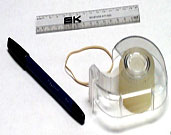Experiment - The Hubble Constant
The Effect of Distance on Speed
In the 1920s Edwin Hubble discovered that all galaxies in the universe are moving away from us. He also found something even more astounding: the farther a galaxy is from our own, the faster it is moving away from us. A rubber band can be used as a one-dimensional model of our universe to help us understand why Hubble’s second discovery makes sense.
Tools & Materials
|
|
The Experiment
Work with a partner, if possible. Here’s what to do:
|
1. |
Use the scissors to cut once across the rubber band to make a single length. |
||
|
2. |
Place the cut rubber band along the ruler so that one end of the rubber band is lined up with the zero cm line. |
||
|
3. |
Use the pen to make a thin mark on the rubber band next to every centimeter line. NOTE: Do not stretch the rubber band when making these marks! |
|
|
|
4. |
Imagine that the mark at the one-centimeter line is our Milky Way galaxy. Label this mark “MW” on the rubber band. This will be our reference. The other marks on the rubber band represent other galaxies in the universe that are farther away from the Milky Way. Label them with the letters of the alphabet. |
|
|
|
5. |
Now line up the Milky Way (MW) reference with the end of the ruler. The rest of the galaxy marks on the rubber band should line up with the other centimeter lines. This shows how far away each of the other galaxies is from the Milky Way initially. Record these values in the first column of the data table. |
|
|
|
6. |
Hold the rubber band at each end. Stretch the rubber band so that the Galaxy A mark moves from the one-centimeter line to the two-centimeter line. Make sure that the Milky Way reference remains aligned with the end of the ruler. Read the stretched distance from the Milky Way for each galaxy. Have your partner record these measurements in the next column of your data table. |
|
|
|
|
NOTE: If you are working by yourself, use tape to hold down one end. Put firm pressure on the tape in contact with the rubber band to keep it from slipping. When you are ready to record your data, use one hand to pull the rubber band and the other hand to adjust the ruler and write down your measurements. Take your data quickly because the rubber band will begin to slip out from under the tape at some point. You can see this starting to happen in the photograph here. The MW mark has already slipped a little past the zero-centimeter line. |
|
|
|
7. |
Subtract the stretched distance from the initial distance for each galaxy to find the total distance it moved. Record these results in the third column of the data sheet. |
||
|
8. |
Assume that it took you one-half second (0.5 s) to stretch the rubber band. This was the time it took for each galaxy to move to its new position. Calculate the speed of each galaxy and record the results in the final data sheet column. To calculate the speed of a galaxy, divide the total distance moved by 0.5 s, the time needed for the movement. |
||
Data Sheet |
||||
| Galaxy | Initial Distance from Milky Way (cm) | Stretched Distance from Milky Way (cm) | Total Distance Moved (cm) | Galaxy Speed (cm/s) |
| A | ||||
| B | ||||
| C | ||||
| D | ||||
| E | ||||
| F | ||||
| G | ||||
What do you notice about the speeds of the different galaxies on the rubber band as they get farther from the Milky Way? Does your data support what Edwin Hubble discovered? Why or why not? Are the other galaxies on the rubber band moving towards or away from the Milky Way?
To see the trend in your data clearly, you may want to make a graph of the galaxies showing the initial distance from the Milky Way on the horizontal axis and the galaxy speed on the vertical axis.
Try for yourself then click here [1] to see our results.
This content has been re-published with permission from SEED. Copyright © 2025 Schlumberger Excellence in Education Development (SEED), Inc.
Course:
- Science [4]






